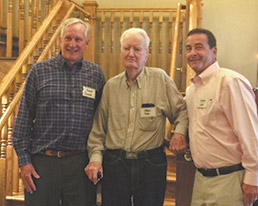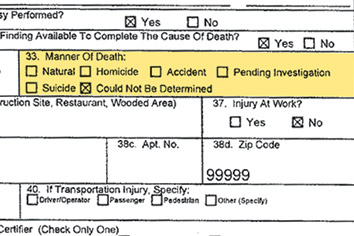Subscriber Benefit
As a subscriber you can listen to articles at work, in the car, or while you work out. Subscribe NowBill Plume spent most of his life telling anyone who would listen that his son Michael’s death at Indiana University in 1960 was not suicide. Just before Plume’s 100th birthday, someone did listen.
“I don’t know what the word is,” Plume said of learning that Monroe County Coroner Joani Shields agreed to amend the official coroner’s verdict of his son’s death, changing the official cause to undetermined. “It’s what I think should have been done in the beginning, but wasn’t,” Plume said.
Plume, who’ll turn 100 on Sept. 5, has fought since his son’s death 57 years ago to correct the record. “I knew I was facing a brick wall, and I didn’t know whether it would happen in my lifetime or not, but I didn’t quit trying because of that,” he said.
Attorneys Greg Laker at Cohen & Malad LLP in Indianapolis and Richard Toussaint in Plume’s hometown of Evergreen, Colorado, also have been involved most of their professional lives in pushing to revise the coroner’s verdict of suicide, a determination they say was deeply flawed and not supported by the evidence.
“It’s definitely a record-breaker for me,” said Laker, who’s worked on the case since 1993. While Plume can’t find the exact words for how it feels to resolve this case, his Indiana counsel can.
“I can tell you how the lawyers felt,” Laker said. “Genuine joy and relief that after all these years, we were able to bring some peace to Bill and his family.”
‘No way’

 Michael Plume
Michael PlumeMichael Plume was 18 in 1960, and he was going places. The oldest of six sons, he had enlisted in the Air Force. Near the height of the Cold War, having taken some Russian classes in high school made him a prime candidate for the service’s Russian linguistics program at IU. After training, he would have been bound for an Air Force listening station to monitor Soviet activities.
“He was one of the five honor students in a language program of 140 airmen,” his father said. By all accounts, he was well-adjusted, cheerful and optimistic. All of which made inexplicable the events of Feb. 15, 1960.
Michael Plume’s body was found slumped at the base of a scaffold, a noose around his neck, at IU’s Memorial Stadium, which then was under construction. Bill Plume said he learned of his son’s death when a Denver newspaper reporter called. Then-Bloomington Police Chief George Huntington concluded Michael Plume hanged himself and promptly released Michael Plume’s identity. Then-Monroe County Coroner Dr. Neal Baxter soon agreed it was suicide, though no autopsy was conducted prior to the verdict.
Bill Plume never accepted it, and as time passed, evidence mounted that weighed against the suicide verdict. “I talked with (Michael) within 50 hours of when he died in that stadium,” he said, recalling a phone conversation. His son told him he’d done well on an exam, and he was looking forward to his career in the Air Force. “There was no way he took his own life. He had no reason to.”
After the Air Force Office of Special Investigations intervened, the coroner corrected the record and concluded Michael Plume’s neck had not been broken, despite the ruling of suicide by hanging.
Troubling questions
Toussaint, Bill Plume’s local counsel in Colorado, has worked on this case since 1984. “Once I reviewed the many, many anomalies in the whole death scene, it just didn’t make any sense,” he said. Michael Plume’s shoes were spit-shine clean, despite muddy conditions outside and a dusty, dirty construction site. The scaffolding where his body was found slumped at the base was wobbly yet intact, despite the long rope being tied off on the scaffolding 30 or more feet above.
The rope held another mystery: It contained fibers from an Air Force glove like those Michael Plume was wearing when his body was found. But the gloves he wore bore no trace of fiber from the rope.
“There were too many things that were just wrong,” Toussaint said.
After Shields took office in January, Bill Plume and his lawyers provided her all the information they had — some 300 pages including parts of the OSI report — and she agreed to re-examine the case. “I felt that was my duty,” she said. “I took the time, and I felt it needed to be looked at, and there’s no reason why I wouldn’t.”
As she looked at the case with fresh eyes, she was troubled by Michael Plume’s clean clothes and shoes in the muddy, dirty construction zone. She was bothered by the scaffolding, the position of his body and by the rope. And after reviewing the case, consulting investigators and other coroners, she couldn’t abide the 57-year-old assumption of suicide that, to her, was unsupported by the evidence.
“I think there were several moments going through where I said, ‘This makes no sense,’” Shields said about reviewing the case. “I feel the coroner is the voice for those who passed away to tell their side of the story. … I don’t think Michael’s story was told 100 percent correctly.”
In May, Shields sent Bill Plume a letter. “I have decided that the manner of death should reflect a ruling of undetermined,” she wrote. “I have carefully reviewed the documents and it does raise doubt that your son, Michael Plume, did in fact, commit suicide.”
Shields said there was insufficient evidence to rule the death a homicide, which would have meant reopening a case for which there appear to be few, if any, living witnesses. Bill Plume said he’s pleased with the result, even though he knows the likeliest explanation is homicide. “The people, I think, who did this are all a long time dead,” he said.

 Bill Plume (center) hosted Indianapolis attorney Greg Laker (right) and attorney Robert Toussaint in his Colorado home in July after a coroner changed the cause of Plume’s son’s 1960 death. (Photo courtesy of Greg Laker)
Bill Plume (center) hosted Indianapolis attorney Greg Laker (right) and attorney Robert Toussaint in his Colorado home in July after a coroner changed the cause of Plume’s son’s 1960 death. (Photo courtesy of Greg Laker)Mission accomplished
Laker traveled to Evergreen in July where he gathered with Bill Plume, his five sons, Toussaint and others, where Plume thanked the many people who assisted him for so many years. Laker said Plume gave a speech to those who’d helped him prove his case, and he ended by telling those assembled, “I’ve learned one thing in 57 years — you can’t fight city hall, but you can outlive them.”
“It was an end, frankly, that I didn’t think we would ever see,” Laker said. “It’s really rewarding.”
“What I conclude from all of this is coroners should be very careful when they issue opinions they can’t really support,” Plume said. “It means something to the families of the deceased.”
Laker and Toussaint conclude something from this as well. There are few options available in Indiana — or in Colorado, for that matter — to challenge a coroner’s verdict. Toussaint said there’s “no forum in a case where the coroner’s office has acted to stonewall and cover up an investigation.” Laker said without Shields’ willingness to challenge a predecessor’s ruling and reconsider the evidence as a whole, Bill Plume still would be fighting.
“There are not very many statutes that dictate how a coroner is supposed to do their job, and there’s less case law about how a family gets relief” when a coroner’s ruling is disputed, Laker said.
Back in Bloomington, Shields related a spine-tingling story. She said as she changed Michael Plume’s cause of death on the official death certificate, the power went out for about 10 seconds, and a colleague’s cellphone inexplicably vibrated, though no calls or messages had been received.
“There are so many questions that are unanswered and will never be answered,” she said.•
Please enable JavaScript to view this content.

